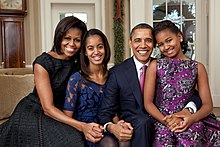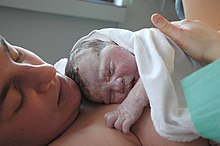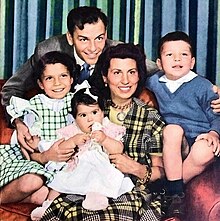Parent

Aparentis either the progenitor of a child or, inhumans,it can refer to a caregiver orlegal guardian,generally called anadoptive parentorstep-parent.Thegametesof a parent result in a child, a male through the sperm, and a female through the ovum. Parents who are progenitors arefirst-degree relativesand have 50% genetic meet. Afemalecan also become a parent throughsurrogacy.Some parents may beadoptiveparents, who nurture and raise an offspring, but are not related to the child.Orphanswithout adoptive parents can be raised by theirgrandparentsor otherfamily members.
A parent can also be elaborated as anancestorremoved onegeneration.With recent medical advances, it is possible to have more than two biological parents.[1][2][3]Examples ofthird biological parentsinclude instances involving surrogacy or a third person who has provided DNA samples during an assisted reproductive procedure that has altered the recipients' genetic material.[4]
The most common types of parents aremothers,fathers,step-parents,andgrandparents.A mother is "a woman in relation to a child or children to whom she has given birth."[5]The extent to which it is socially acceptable for a parent to be involved in their offspring's life varies from culture to culture, however one that exhibits too little involvement is sometimes said to exhibitchild neglect,[6]while one that is too involved is sometimes said to beoverprotective,cosseting,nosey,orintrusive.[7]
Types
[edit]Biological
[edit]
A person's biological parents are the persons from whom the individual inherits theirgenes.The term is generally only used if there is a need to distinguish an individual's parents from their biological parents, For example, an individual whose father has remarried may call the father's new wife theirstepmotherand continue to refer to their mother normally, though someone who has had little or no contact with their biological mother may address theirfoster parentas their mother, and their biological mother as such, or perhaps by her first name.[citation needed]
Mother
[edit]
A mother is a female who has a maternal connection with another individual, whether arising fromconception,by givingbirthto, orraisingthe individual in the role of a parent.[8]More than one female may have such connections with an individual. Because of the complexity and differences of a mother's social, cultural, and religious definitions and roles, it is challenging to define a mother to suit a universally accepted definition. The utilization of a surrogate mother may result in explication of there being two biological mothers.[9]
Father
[edit]
A father is a male parent of any type of offspring.[10]It may be the person who shares in the raising of a child or who has provided the biological material, thesperm,which results in the birth of the child.
Grandparent
[edit]Grandparents are the parents of a person's own parent, whether that be a father or a mother. Every sexually reproducing creature who is not agenetic chimerahas a maximum of fourgeneticgrandparents, eight geneticgreat-grandparents,sixteen genetic great-great-grandparents and so on. Rarely, such as in the case of sibling or half-siblingincest,thesenumbers are lower.
Paternity issues
[edit]A paternity test is conducted to prove paternity, that is, whether a male is the biological father of another individual. This may be relevant in view ofrightsand duties of the father. Similarly, a maternity test can be carried out. This is less common, because at least duringchildbirthandpregnancy,except in the case of a pregnancy involvingembryo transferoregg donation,it is obvious who themotheris. However, it is used in a number of events such as legal battles where a person's maternity is challenged, where the mother is uncertain because she has not seen her child for an extended period of time, or where deceased persons need to be identified.
Although not constituting completely reliable evidence, severalcongenital traitssuch as attachedearlobes,awidow's peak,or thecleft chin,may serve as tentative indicators of (non-) parenthood as they are readily observable and inherited viaautosomal-dominantgenes.
A more reliable way to ascertain parenthood is via DNA analysis (known asgenetic fingerprintingof individuals), although older methods have includedABO blood group typing,analysis of various otherproteinsandenzymes,or usinghuman leukocyte antigens.The current techniques for paternity testing are usingpolymerase chain reactionandrestriction fragment length polymorphism.For the most part, however, genetic fingerprinting has all but taken over all the other forms of testing.
Roles and responsibilities
[edit]Guardianship
[edit]A legal guardian is a person who has the legal authority (and the corresponding duty) to care for the personal and property interests of another person, called a ward. Guardians are typically used in three situations: guardianship for an incapacitated senior (due to old age or infirmity), guardianship for a minor, and guardianship fordevelopmentally disabledadults.
Most countries and states have laws that provide that the parents of a minor child are the legal guardians of that child, and that the parents can designate who shall become the child's legal guardian in the event of death, subject to the approval of the court. Some jurisdictions allow a parent of a child to exercise the authority of a legal guardian without a formal court appointment. In such circumstances the parent acting in that capacity is called the natural guardian of that parent's child.
Parenting
[edit]Parentingor child rearing is the process of promoting and supporting thephysical,emotional,social, financial, andintellectual developmentof achildfrominfancytoadulthood.Parenting refers to the aspects of raising a child aside from the biological relationship.[11]
Gender and gender mix
[edit]A child has at least one biologicalfatherand at least one biologicalmother,but not everyfamilyis a traditionalnuclear family.There are many variants, such asadoption,shared parenting,stepfamilies,andLGBT parenting,over which there has been controversy.
The social science literature rejects the notion that there is an optimal gender mix of parents or that children and adolescents withsame-sex parentssuffer any developmental disadvantages compared with those with two opposite-sex parents.[12][13]The professionals and the major associations now agree there is a well-established and accepted consensus in the field that there is no optimal gender combination of parents.[14]The family studies literature indicates that it is family processes (such as the quality of parenting and relationships within the family) that contribute to determining children's well-being and "outcomes", rather than family structures, per se, such as the number, gender, sexuality and co-habitation status of parents.[13]
Genetics
[edit]Parent–offspring conflict
[edit]An offspring who hates their father is called a misopater, one that hates their mother is a misomater, while a parent that hates their offspring is a misopedist.[15][16]Parent–offspring conflict describes theevolutionary conflictarising from differences in optimalfitnessof parents and theiroffspring.While parents tend to maximize the number of offspring, the offspring can increase their fitness by getting a greater share ofparental investmentoften by competing with theirsiblings.The theory was proposed byRobert Triversin 1974 and extends the more generalselfish gene theoryand has been used to explain many observed biological phenomena.[17]For example, in somebirdspecies, although parents often lay two eggs and attempt to raise two or more young, the strongest fledgling takes a greater share of the food brought by parents and will often kill the weaker sibling, an act known assiblicide.
Empathy
[edit]David Haig has argued that humanfetalgenes would be selected to draw more resources from the mother than it would be optimal for the mother to give, a hypothesis that has received empirical support. Theplacenta,for example, secretes allocrinehormonesthat decrease the sensitivity of the mother toinsulinand thus make a larger supply of blood sugar available to the fetus. The mother responds by increasing the level of insulin in her bloodstream, the placenta has insulin receptors that stimulate the production of insulin-degradingenzymeswhich counteract this effect.[18]
Having children and happiness
[edit]
In Europe, parents are generally happier than non-parents. In women, happiness increases after the first child, but having higher-order children is not associated with further increased well-being. Happiness seems to increase most in the year before and after the first childbirth.[19]
See also
[edit]- Adoption
- Bateman's principle
- Child abuse
- Cinderella effect
- Eggandsperm donation
- Foster care
- Infant
- Infanticide
- Narcissistic parent
- Non-paternity event
- Parental abuse by children
- Parental age (disambiguation)
- Parental bullying of children
- Parental investment
- Parental narcissistic abuse
- Parents bullying teachers
- Paternal bond
- Paternity (law)
- Reciprocal socialization
- Stepparent
- Surrogate mother
- Teachers bullying parents
- Honour thy father and thy mother
References
[edit]- ^Gallagher, James (2013-06-28)."UK government backs three-person IVF".BBC News.Retrieved30 June2013.
- ^Nadine Taub;Beth Anne Wolfson; Carla M. Palumbo.The Law of Sex Discrimination.p. 374.
- ^Browne C. Lewis (2012).Papa's Baby: Paternity and Artificial Insemination.p. 136.
- ^Louise I. Gerdes (2009).Reproductive Technologies.p. 25.
- ^"mother definition".www.oxforddictionaries.com.Oxford Dictionaries. Archived fromthe originalon October 10, 2012.
- ^Marian S Harris (2014).Racial Disproportionality in Child Welfare.p. 2.
- ^Bernard Roberts (2005).Evidence in the Psychological Therapies: A Critical Guidance for Practitioners.p. 149.
- ^"Definition from".Allwords.com. 2007-09-14.Retrieved2011-11-04.
- ^Bromham, David (1990).Philosophical Ethics in Reproductive Medicine.p. 57.
- ^"TheFreeDictionary".Retrieved2014-10-07.
- ^Davies, Martin (2000).The Blackwell encyclopedia of social work.Wiley-Blackwell. p. 245.ISBN978-0-631-21451-9.
- ^Lamb, Michael (2009).Affidavit – United States District Court for the District of Massachusetts[permanent dead link]
- ^abShort, Elizabeth; Riggs, Damien W.; Perlesz, Amaryll; Brown, Rhonda & Kane, Graeme."Lesbian, Gay, Bisexual and Transgender (LGBT) Parented Families – A Literature Review prepared for The Australian Psychological Society"(PDF).Archived fromthe original(PDF)on 2011-03-04.Retrieved2011-11-04.
- ^"In The Supreme Court of Iowa No. 07–1499"(PDF).Archived fromthe original(PDF)on 2009-12-29.Retrieved2011-11-04.
- ^Francis, Darryl. "Iatrologs and Iatronyms." Word Ways 4.2 (1971): 8.
- ^Davies, Jon. "Imagining intergenerationality: Representation and rhetoric in the pedophile movie." GLQ: A Journal of Lesbian and Gay Studies 13.2 (2007): 369-385.
- ^Trivers, R.L. (1974)."Parent–offspring conflict".Integrative and Comparative Biology.14(1): 249–264.doi:10.1093/icb/14.1.249.JSTOR3881986.
- ^Haig, D. (1993)."Genetic conflicts in human pregnancy"(PDF).The Quarterly Review of Biology.68(4): 495–532.doi:10.1086/418300.JSTOR3037249.PMID8115596.S2CID38641716.Archived fromthe original(PDF)on 2013-07-19.
- ^Nicoletta Balbo; Francesco C. Billari; Melinda Mills (2013)."Fertility in Advanced Societies: A Review of Research".European Journal of Population.29(1): 1–38.doi:10.1007/s10680-012-9277-y.PMC3576563.PMID23440941.
External links
[edit]- National Educational Network, Inc. (NENI)– free online resources for parent education, curriculum. They also have a parent blog with information about child care, after-school, trends in education, tutoring, college, grants, etc.
- Herbermann, Charles, ed. (1913)..Catholic Encyclopedia.New York: Robert Appleton Company.– ARoman Catholicview of the position of parents.
